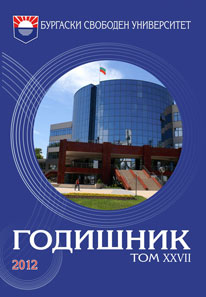
WEB БАЗИРАН ИНТЕРФЕЙС ЗА VOIP ТЕЛЕФОН LINPHONE
The goal of this paper is to present a developed web based interface for the VoIP telephone Linphone. The interface can be used in any projects and ideas with mobility option and OS independence
More...We kindly inform you that, as long as the subject affiliation of our 300.000+ articles is in progress, you might get unsufficient or no results on your third level or second level search. In this case, please broaden your search criteria.

The goal of this paper is to present a developed web based interface for the VoIP telephone Linphone. The interface can be used in any projects and ideas with mobility option and OS independence
More...
The practice of the Member States in the EU related to the e-justice includes the introduction of information and communication technologies in judicial proceedings in the administrative services of the courts and the provision of legal information and documents electronically. The European e-Justice must fulfill three basic functions in terms of access to information in the field of justice, electronic communication between the court and the parties concerned, and to simplify and promote the exchange of information between judicial authorities in the Member States. In view of this development and implementation of an information system of enforcement is crucial, not only the expected effect on the affected public relations internally, but also as a means of fulfilling the obligations imposed as a result of Bulgaria‘s membership in the EU. Information System for Management of court cases lead to faster and more efficient service, as well as to greater precision by the magistrates and court officials. Bulgaria’s Supreme Judicial Council has approved four systems for case management, а a Web-based interface for court rulings is introduced, integrated with the four IS.
More...
Officially, there is currently no uniform standard and minimum requirements for what should be contained in the website of the court, although the need for this is found in the Law on the Judiciary. This led to the need to establish a methodology for monitoring the information resources of the authorities oriented towards the requirements for the composition and nature of the information to the official sites of the authorities. Started in 2013, the study continued in the coming years, complementing and analyzing the results of empirical research, to formulate recommendations to the SJC. The evaluation of sites was held to previously developed and discussed parameters. The results obtained in the 13 sets of indicators are shown in total number of points obtained from maximum possible number - 81. Displayed indexes are grouped by degree of maturity in 5 levels.
More...
This article presents an experience report regarding the application of an Inclusive Model of Development of Accessible Learning Objects, in the Mathematics discipline, to help 8th year Elementary School children, to perform calculations with natural numbers. The Learning Object was developed using Scratch and accessibility guidelines to include students with disabilities. The model evaluated the learning, teaching, usability, and accessibility of objects. The results demonstrate the efficiency, interaction and improvement in students' performance in Mathematics, through the use of objects in the teaching and learning process.
More...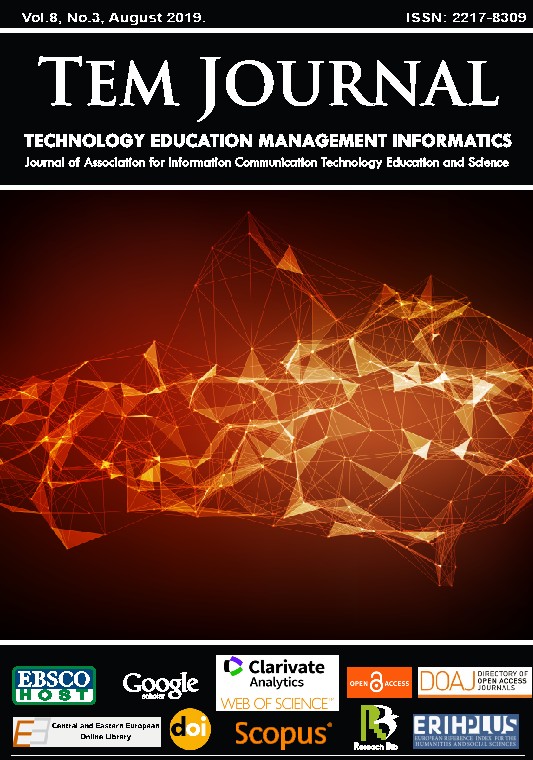
This paper deals with the design of the printhead prototype with extruder which serves for universal processing using several types of materials. It briefly describes the basic principles of FDM technology for which the prototype is designed. The main goal is to explore the possibility of combining 3D printing, and robot technology in order to design a universal printhead, capable of printing from plastic, recycled materials and other substances, including the composites. The proposed concept allows printing oversized objects that are not limited by the relatively small working space compared to commercial FDM devices.
More...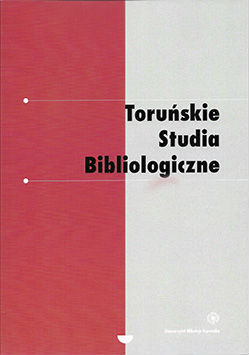
The article describes the specifics of usability research in public institutions on the example of work at the National Information Processing Institute. It describes the challenges faced by system creators, designers, and researchers. It presents methods of preparing and conducting usability tests (preparation, execution and further steps after researches). Characterization of systems created in the institute: POL-on, JSA shows specifics of working at the public systems and shares the insights from these researches. Based on the gathered information, the article proposes changes to improve the experience of systems’ users. It presents good practices that the creators may follow during the designing process, such as: naming, icons, charts, cohesion, searching, text editing and information architecture.
More...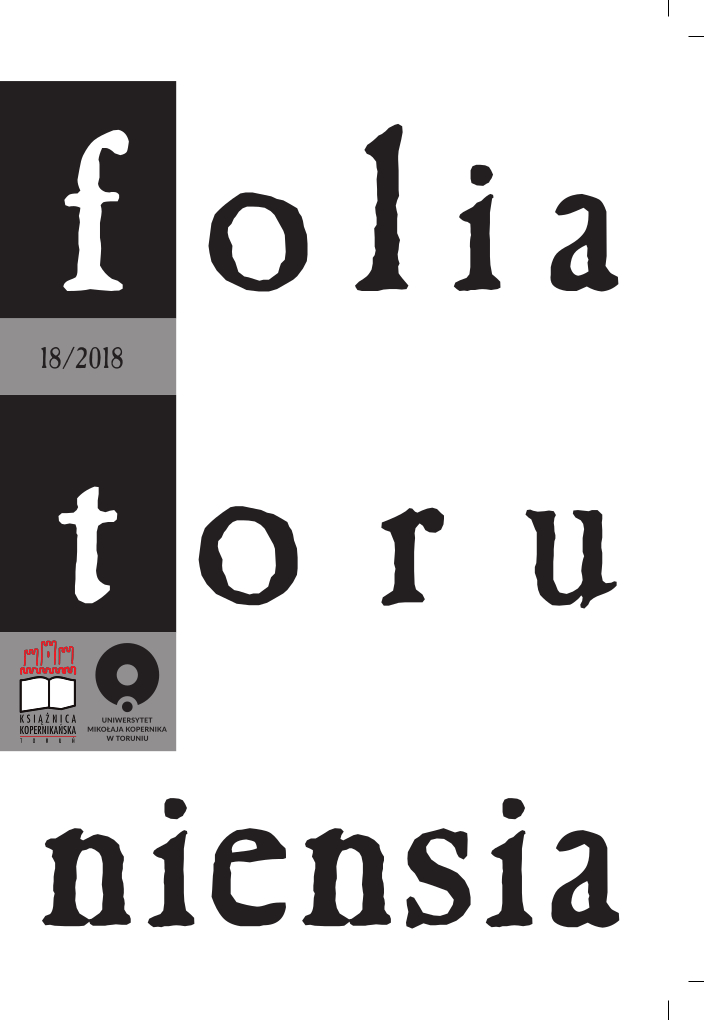
Aim: The aim of this paper is to introduce the evolutionary process of information service tools used in libraries through the system of Hungarian information sources on shipping. In the first part we describe a possible model for collecting, identifying, analysing and publishing Hungarian scientific literature on shipping. In the next part we describe the current situation in Hungary, especially regarding content accessible online for free, published by public administration bodies, and professional and non-governmental organizations. Finally, we discuss possible future courses of development. Research method: Our research is based on scientific literature, professional consultations, our own data collection, and experiences. Our work, especially the identification and use of documents and modern infocommunicational applications, is largely based on selection and assessment performed during library information service, on systems approach, and on looking for connections. We aimed to use English references in the paper, but in those cases where no such sources were found, and it was necessary for understanding the point, we listed Hungarian bibliographic entries. Results/Conclusions: The development of information service systems related to shipping and aimed at current events is inconceivable without involving the latest IT innovations, the cooperation of different fields, and the support networks of the European Union. The future is services providing aggregated, multi-criteria searching. Other nations can draw inspiration from analysing Hungary’s developmental curve and trends to meet both the scientific and the veryday needs for sources in the field. Moreover, this paper can help Hungarian developments to be linked with further international information systems.
More...
Aim: The aim of the study was to gain knowledge about the way in which students use the electronic bibliography when looking for their positions. These investigations are designed to indicate the most intuitive bibliographic description style from the student's level. It is also to contribute to the improvement of the aesthetics of the ways of publishing the subject bibliography presented in the didactic support services and in the electronic management systems of students and academic staff.Research method: The study in question was conducted using a mobile eye tracker, operating in infrared technology and 60 Hz frequency, on the group of students of Information Architecture. In order to achieve a balanced degree of complexity for different bibliographic styles, the experiment, apart from using the eye tracker, also included a questionnaire concerning detailed questions in the field of particular elements of the bibliographic description. The study used the Vancuver style, Traditional Polish agreement with the norm (PN-ISO 690: 2002 and PN ISO 690 2) mixed and the style based only on network resources.Results/Conclusions: These are pilot studies, and their results will be presented on the example of the USOS website, which is used at Nicolaus Copernicus University in Torun.
More...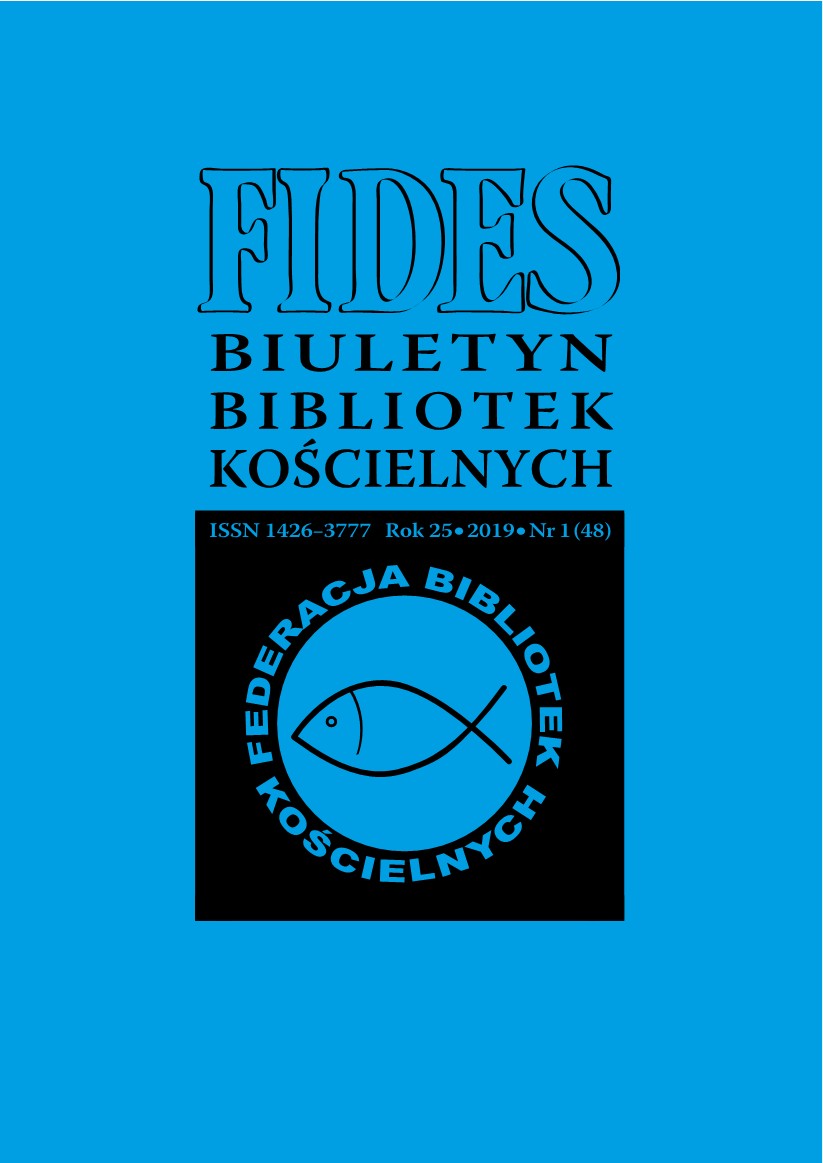
The paper discusses why it is worth having a functional website. The author provides definition of information architecture and describes information architects’ tasks of designing websites. The following components of information architecture are presented: organization schemes and structures, labelling systems, navigation and search systems. All of those elements are briefly described and, where possible, illustrated by screenshots of websites of church libraries associated with „Fides”.
More...
The aim of the paper is to present digital tools for managing personal information. The introduction refers to information overload as a cause of the growing need for information organization, explains what personal information is and what difficulties it causes to researchers, and how to manage this category of information. In the further part of the article, tools (applications, programs) for managing personal information are grouped and their most important functions and possibilities of application are described.
More...
This paper provides a brief introduction of mobile technology applications and its use in library services. The paper also examines the types of mobile applications for librarians, and highlights specific applications that are available to librarians. There are briefly described the prominent features of the application, and the advantages and the potential disadvantages. The author attempts to note important considerations, such as security, reliability, availability, and cost, that library professionals must be aware of before using mobile applications. Mobile applications for access to libraries, except that they allow access to library collections, they enable advanced features, such as lending books, search the archives and others. It is also said that library mobile applications are "libraries that fit in your pocket". We have few libraries that have developed a mobile application, unlike those in the world. The paper will present the expectations and possibilities of using library mobile applications in our country.
More...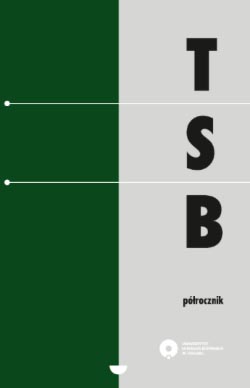
Information architecture design [hereafter: IA] is one of the important elements of information systems development. Depending on the target audience and its conditions, this task may be more or less challenging. A particularly interesting group of recipients are Arabic speakers. According to the latest report by Mohammed Bin Rashid Al Maktoum Global Initiatives and Bayt.com, 47 million new Internet users in the Middle East region are expected to arrive by 2021. Besides, the changes introduced by the authorities of the Middle East countries focus on the latest technologies enabling the management of the state via the Internet and specially designed mobile applications. We can also add to this the extremely high level of information provided by society’s writers, which drives the development of solutions using digital technologies. In the face of the following changes and the growing demand from Middle East user groups, information architects need to familiarize themselves with the IA design principles for the Arabic-speaking user for professional reasons. This is a new and promising niche for information architects which is worth a closer look.
More...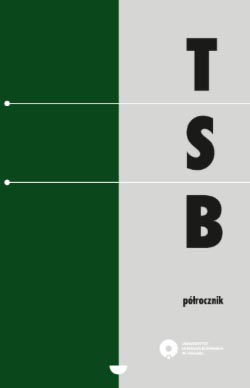
The purpose of this article is to analyze the phenomenon of synesthesia in the context of information architecture. Synesthesia, as a phenomenon of perception of sensations by various senses, can have a positive or negative impact on the reception of the message. Well-designed information will convince the recipient of the content. The creators of websites, applications, advertisements, and equipment try to integrate the senses in the message for the benefit of the recipient. In the information architect’s work, one can see many practical implications of synesthesia. The article, with some prognostic and futurological elements, is to initiate studies on this subject.
More...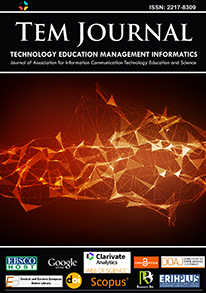
The aim of this research is to survey the current state of research related to the utilization of AI in public services as indexed by Scopus. VOSviewer is used in this research to assess keywords from 183 articles. Furthermore, the Scopus database search results analysis visualizes the characteristics and trends of journals, authors, and subjects connected to the application of artificial intelligence in public service research. Based on the results of this study, it is possible that AI could assist in making cities more intelligent by improving the quality of life for citizens and enhancing the efficiency of their access to public goods and services. It surpasses benchmark models in predicted accuracy because of its more transparent and modifiable model structure. By strategically designing and deploying AI-based technology, traditional public services may be turned into intelligent services. This study contributes to the formation of more relevant research by serving as a reference for future researchers in identifying the position of contribution to the creation of more relevant research.
More...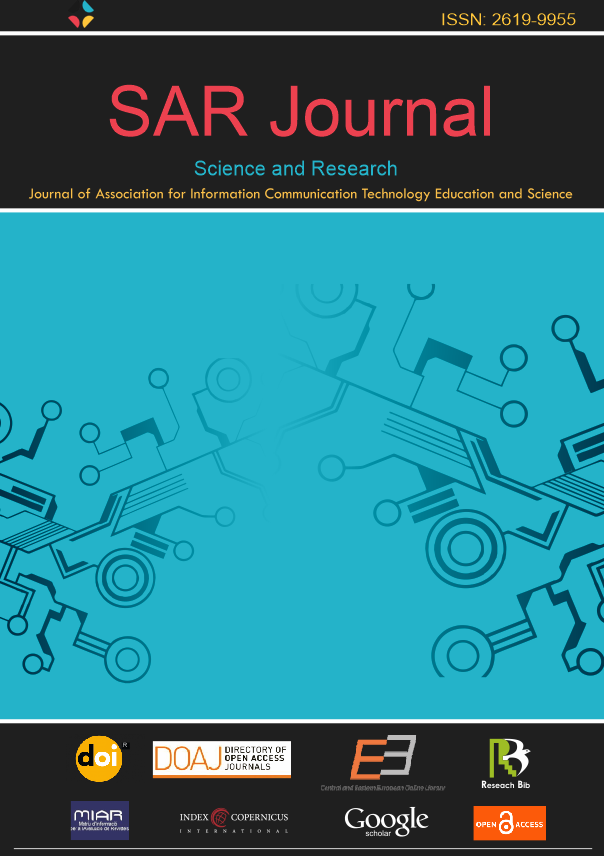
Spatial legibility has been associated in the literature as being comprehensible of the space, easy wayfinding in the space, and being able to draw a cognitive map of the space. This study aims to analyze the scope of spatial legibility research using bibliometric analysis and visualization using VOSviewer. The Web of Science database was utilized to gather information on spatial legibility studies. Title, keywords, and abstract requirements were used to construct the search results, which were based on topic categories from spatial legibility research. The Web of Science database research keywords (TS= ("spatial legibility")) OR TS= ("architectural legibility")) OR TS= ("urban legibility")) OR TS= ("legible cities")) OR TS= ("legible city"). It has been determined that the most used words by the authors in their publications are space syntax, legibility, intelligibility, cognitive map, image, landmark, spatial legibility, urban design, way finding, navigation, virtual environment, and perception. To sum up, this article will give an idea to researchers who will research spatial legibility.
More...
The subject of interest of this paper is the surface quality of manganese steel sheets. The sheets are produced by hot rolling, on an industrial scale, in the Makstil AD Steel Mill in Skopje. Several surface defects were detected; however, the appearance of edge waves in the hot rolling process was especially analyzed. For this purpose, the change of the geometrical parameters of manganese steel sheets was monitored during the hot rolling process and measurements of the sheet flatness were done. Furthermore, some of the more important technological parameters of the rolling process were followed – reduction degree, temperature, velocity and rolling force, in each of the passes, in the course of the plastic deformation. The knowledge obtained indicates that sheets with quality surface and without edge waves are produced with higher rolling velocities, higher rolling temperatures and lower rolling forces. This finding can serve for defining optimal sheet processing conditions, at which absence of edge waves and satisfactory flatness quality of the steel sheets can be accomplished.
More...
This paper presents a new approach to formalizing the general rules of the Hoare logic. Our way is based on formulas of the first-order predicate logic defined over the abstract state space of a virtual machine, i.e. so-called S-formulas. S-formulas are general tool for analyzing program semantics in as much as Hoare triples of total and partial correctness are not more than two S-formulas. The general rules of Hoare logic, such as the laws of consequence, conjunction, disjunction and negation can be derived using axioms and theorems of first order predicate logic. Every proof is based on deriving the validity of some S-formula, so the procedure maybe automated using automatic theorem provers. In this paper we will use Coq.
More...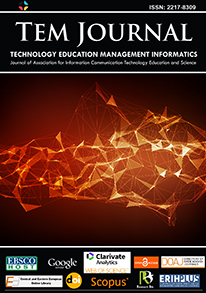
In specialised food products, the detection and identification of various sources of oils and fats are essential. Consumers are concerned about the adulteration of vegetable oils to avoid health problems and the risk of developing heart disease. There were a few cases where less expensive animal fat, in particular pork fat, was found in halal meals. The limitations of conventional methods for detecting pork in other meats can be overcome with the use of non-destructive methods. This study reveals the feasibility of using the microwave non-destructive testing method to identify animal fats. In the frequency between 8 GHz and 12 GHz, the microwave non-destructive testing method was used to obtain the S-parameters of the chicken, beef, and pork fats in the form of raw, baked, and oil. Single and multiple correlation analyses were then performed to identify the relationship between the animal fats and to differentiate them. The results of the Pearson correlation analysis show that for all animal fats, both raw and baked fat had a higher correlation value, which indicated they have the same or similar features. The different correlation values obtained from the multiple correlation analysis demonstrated that animal fats have distinct features, regardless of whether they are raw, baked, or liquid forms. The multiple correlation analysis is a more suitable technique to detect animal fats compared to the Pearson correlation analysis.
More...
This paper aims to develop a photovoltaic (PV) performance monitoring system applied on a micro scale using the Internet of Things (IoT). Previous monitoring systems had limitations in platform flexibility, low-cost devices, hardware complexity, and stability of the data transfer process. For this reason, this research proposes an IoT architecture that uses Arduino devices, mini WIFI and an open-source platform, so that it can be easily developed further. This research also develops innovations in controlling the use of electrical energy sources from PV and utility networks. This monitoring system is applied to PV installations with a capacity of 1KW which is capable of monitoring electrical data in the form of current, voltage, power, energy and frequency obtained from PV panels, batteries, loads and electrical utilities. Monitoring data is displayed in a visual form that can be accessed via web-based and mobile applications. This research has developed an innovation in controlling the use of electrical energy sources from PV and Utility networks by using several sensors as parameters to determine the right time and condition in controlling the use of electrical resources.
More...
The understanding of the metaverse is currently expanding, and several interpretations and implementations may be present. The many metaverse iterations have distinct components and capabilities, which have the potential to evolve and enhance over time in tandem with technological advancements and evolving user requirements. The metaverse has emerged as a widely discussed subject of public interest, with individuals and organizations alike contemplating its potential applications. However, a prevailing misperception persists over its fundamental comprehension. The concept of the metaverse is often misconstrued as solely referring to a virtual world; nevertheless, it encompasses more than simply a virtual realm. Three other categories can be classified as constituting the metaverse. The metaverse encompasses four distinct categories, each characterized by unique aspects that may or must diverge from one another. The elements play a crucial role in the development of any metaverse kind. This work aims to provide a valuable contribution by offering a comprehensive analysis of the constituent features of various metaverse types. Its purpose is to assist anyone interested in studying or implementing a certain metaverse type by fostering a deeper understanding of its core aspects.
More...